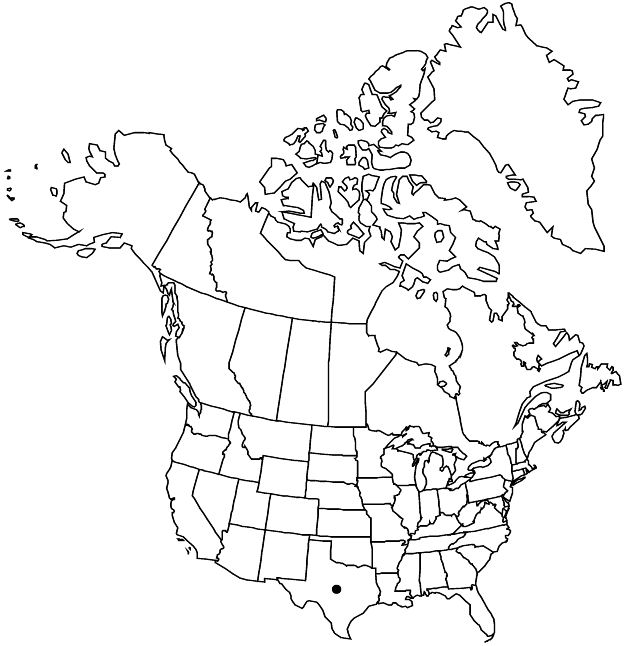Difference between revisions of "Hermannia texana"
Gen. Amer. Bor. 2: 88, plate 135. 1849.
FNA>Volume Importer |
FNA>Volume Importer |
||
| Line 24: | Line 24: | ||
|elevation=20–700 m | |elevation=20–700 m | ||
|distribution=Tex.;Mexico (Coahuila;Nuevo León;Tamaulipas). | |distribution=Tex.;Mexico (Coahuila;Nuevo León;Tamaulipas). | ||
| − | |discussion=<p>Hermannia texana is found in the Texas upland prairies and coastal plain regions. It occurs usually in scattered colonies and sometimes is locally common. Plants are eaten by deer, sheep, goats, and cows.</p><!-- | + | |discussion=<p><i>Hermannia texana</i> is found in the Texas upland prairies and coastal plain regions. It occurs usually in scattered colonies and sometimes is locally common. Plants are eaten by deer, sheep, goats, and cows.</p><!-- |
| − | --><p>Leaves of Hermannia texana are variable in shape and size. A. Gray (1850) later corrected the corolla color to cinnabar, and the corolla attitude to be convolute and erect, never spreading as originally figured and described.</p><!-- | + | --><p>Leaves of <i>Hermannia texana</i> are variable in shape and size. A. Gray (1850) later corrected the corolla color to cinnabar, and the corolla attitude to be convolute and erect, never spreading as originally figured and described.</p><!-- |
--><p>Fresh flower styles are usually coherent completely or to 1 mm below the recurved apex. The flowers attract halictid and anthophorid bees. The large bee Centris atripes Mocsary is probably an effective pollinator (Saunders, unpubl.).</p> | --><p>Fresh flower styles are usually coherent completely or to 1 mm below the recurved apex. The flowers attract halictid and anthophorid bees. The large bee Centris atripes Mocsary is probably an effective pollinator (Saunders, unpubl.).</p> | ||
|tables= | |tables= | ||
| Line 50: | Line 50: | ||
|publication year=1849 | |publication year=1849 | ||
|special status= | |special status= | ||
| − | |source xml=https://jpend@bitbucket.org/aafc-mbb/fna-data-curation.git/src/ | + | |source xml=https://jpend@bitbucket.org/aafc-mbb/fna-data-curation.git/src/8f726806613d60c220dc4493de13607dd3150896/coarse_grained_fna_xml/V6/V6_371.xml |
|subfamily=Malvaceae subfam. Byttnerioideae | |subfamily=Malvaceae subfam. Byttnerioideae | ||
|genus=Hermannia | |genus=Hermannia | ||
Revision as of 17:47, 18 September 2019
Plants 50–70 cm, densely stellate-tomentose to glabrescent. Stems usually ascending to erect, sometimes decumbent, stellate-tomentose, inconspicuously glandular. Leaves: stipule triangular, 3–4 × 1–2 mm, adaxially both stellate and simple hairs present; petiole 12–27 × 0.8–2 mm, eglandular; blade olive, unlobed, sometimes 1–2(–6)-lobuled, elliptic to oblate, narrowly ovate to widely ovate, oblong-ovate, orbiculate, or depressed-obovate, rounded, rounded-obtuse, or broadly obtuse, rarely acute. Inflorescence subunits at leaf axils, 1–7-flowered. Pedicels 1–3 mm. Flowers 7–12 × 3.2–5.6 mm fresh; calyx 6.5–8.5 × 4–6.4 mm, stellate-hispidulous or stellate-tomentose and minutely glandular abaxially, with tufted trichomes at base adaxially over globular nectaries between hairless nectiferous bands, tube 2.5–4.5 × 5–7 mm, lobes widely deltate, 2–3 mm wide, margins simple-setose, apex acuminate, setose, adaxially villous; corolla urn- or barrel-shaped, 8–9 mm curved, 10–12 mm flat, aperture terminal, never opening wider, petals erect, never spreading, convolute, yellow, becoming yellow-orange to red-orange, pandurate if spread out, 8.4–12 × 3.4–5.9 mm, base clawed, claw distinct, narrowly obtriangular, 4–5.2 × 1.6–2 mm, lamina widely concave between sides (fresh), widely obovate if flattened, distally densely capitate-glandular abaxially; stamens 6.2–9 mm; filaments dark yellow, edges pale yellow, midvein prominent abaxially; stamen tube connate, 1.5–2.5 × 0.7–1.5 mm; free filaments 3.2–3.8 × 0.5–0.6 mm; anthers 2.6–3.5 × 0.6–0.9 mm; theca: base rounded, eglandular, apex acuminate, stellate-bristled, with conspicuous gland; ovary 1.7–2.3 × 1.8–2.4 mm, lanate; gynophore 1.8–2.5 mm; ovules 6–14 per locule; styles connate completely or to 1 mm below apex in fresh and rehydrated specimens, 3.9–5.8 mm, glabrous or scant simple-hirtellous near ovary; stigmas erect or ascending, apex acute, not papillate. Capsules broadly depressed-ovoid to broadly ovoid or broadly ellipsoid, 7–12 mm, delicately stellate-tomentose, sparsely fringed (over nerves) and valve margins densely fringed, fringe processes flexible, filiform, 0.9–3.2 mm, tomentose along length below apex and at apex, trichome rays of terminal trichome of each fringe process ascending, fine, only slightly firmer or slightly longer than trichome rays of proximal hairs below apex; stipe 1.8–3 mm; exocarp membranaceous, mesocarp chartaceous, endocarp corneous, rigid, not fissured; calyx tube 3.4–5.9 mm wide in fruit; dehiscence loculicidal. Seeds 0–6 per cell, 1.3–1.7 × 1.3–1.6 × 0.6–0.7 mm, sinus obtuse, shallowly triangular, covered by narrowly transversely rhombic elaiosome; embryo ± V-shaped, cotyledons narrowly elliptic, papillose and simple-hirsutulous adaxially. 2n = ca. 24.
Phenology: Flowering and fruiting Mar–Nov.
Habitat: Upland prairies, juniper-oak woodlands, Tamaulipan scrub or chaparral, salt-marsh borders, coastal dunes, on granite, limestone, or dry, calcareous soil, clay-loams or black silt, rocky hillsides, streambeds, canyons
Elevation: 20–700 m
Distribution

Tex., Mexico (Coahuila, Nuevo León, Tamaulipas).
Discussion
Hermannia texana is found in the Texas upland prairies and coastal plain regions. It occurs usually in scattered colonies and sometimes is locally common. Plants are eaten by deer, sheep, goats, and cows.
Leaves of Hermannia texana are variable in shape and size. A. Gray (1850) later corrected the corolla color to cinnabar, and the corolla attitude to be convolute and erect, never spreading as originally figured and described.
Fresh flower styles are usually coherent completely or to 1 mm below the recurved apex. The flowers attract halictid and anthophorid bees. The large bee Centris atripes Mocsary is probably an effective pollinator (Saunders, unpubl.).
Selected References
None.